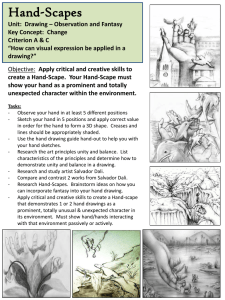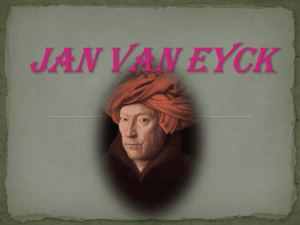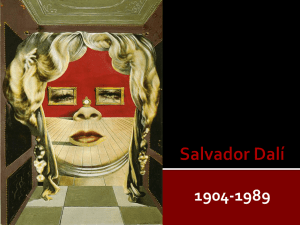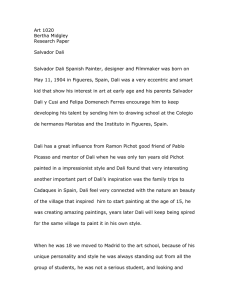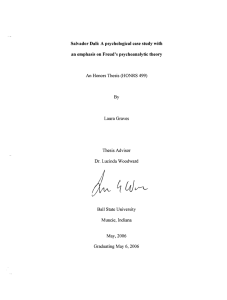Fantasy & Surrealism Powerpoint
advertisement
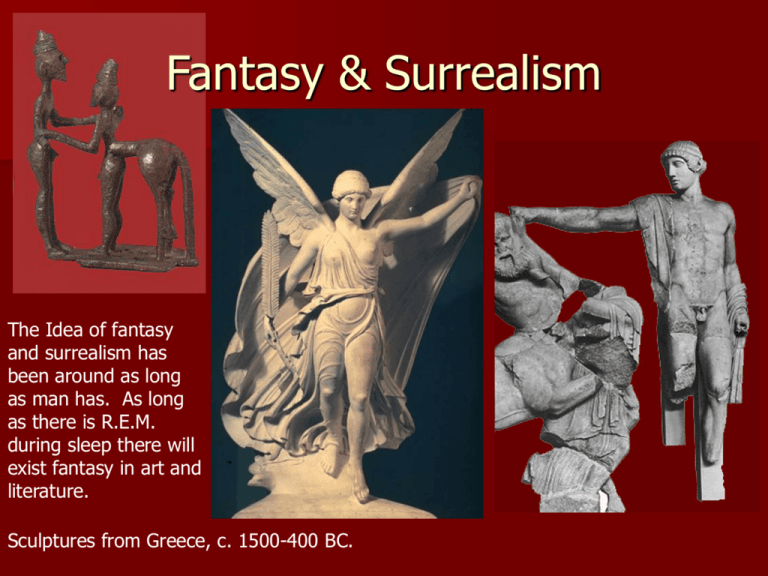
Fantasy & Surrealism The Idea of fantasy and surrealism has been around as long as man has. As long as there is R.E.M. during sleep there will exist fantasy in art and literature. Sculptures from Greece, c. 1500-400 BC. The full circle Boris Vallejo Today, the world of Fantasy/Science Fiction and Surrealism is wide open. We can utilize the Myths and Mythologies of past, present and the fantasies of the future to give rise to the illustrations and drawings of anything on our minds. Jan van Eyck: Jan van Eyck was a Flemish painter who along with Robert Campin was the founder of the Ars Nova ("new art") of 15thcentury northern late Gothic painting. This style heralded the Renaissance in northern Europe. This period of Netherlandish art is characterized by a naturalistic style of vivid oil colors, meticulous detail, accurately rendered textures, and the illusion of three-dimensional space on a two-dimensional surface. This effect is call atmospheric perspective. This particular piece is thought to be Jan's self portrait. It contains a lot of Jan's proposed personality and the frame is signed and dated containing his personal motto, Als ich chan ("The best I am capable of doing"). This motto illustrates the humanist spirit that an artist excepts himself and is proud to display it. Man in a Red Turban, 1433, 10 ¼” X 7 ½” Jan van Eyck Giovanni di Arrigo Arnolfini, a merchant from Lucca and a frequent visitor to Bruges, and his wife Giovanna Cenami. The signature on the back wall in latin- 'Jan Van Eyck was here, 1434' - and his reflection in the mirror has led many to believe that he was a witness to their marriage. The carving of Saint Margaret, the patron saint of childbirth, on the bed, and the presence of the dog - a traditional symbol of faithfulness accentuate the marital theme. Jan Van Eyck is where the term Iconography comes from. An Icon is a picture symbol used to convey meaning or an idea. Like the little pictures on your computer telling you what a program or file is. The marriage of Giovanni Arnolfini and his bride Giovanna, Oil on wooden panel, 1434 Can you find 4 people? Jan painted himself and the priest into the picture as symbolic witnesses to this holy union. Hieronymus Bosch, 1450 – 1516. Triptych of the Garden of Earthly Delights. Creation of Eve (left wing), Garden of Earthly Delights (center), Hell (right wing). Oil on wood Bosch's most famous and unconventional picture is The Garden of Earthly Delights which, like most of his other ambitious works, is a large, 3part altarpiece, called a triptych. This painting was probably made for the private enjoyment of a noble family. It is named for the luscious garden in the central panel, which is filled with cavorting nudes and giant birds and fruit. The triptych depicts the history of the world and the progression of sin. Beginning on the outside shutters with the creation of the world, the story progresses from Adam and Eve and original sin on the left panel to the torments of hell, a dark, icy, yet fiery nightmarish vision, on the right. The Garden of Delights in the center illustrates a world deeply engaged in sinful pleasures. Bosch, 1500 AD One of my favorite panels is the right one. It depicts Bosch’s concept of Hell and the odd things that we envision as the worst of punishments. Some of them are quite graphic and in some ways humorous. BOSCH At the time of his death, Bosch was internationally celebrated as an eccentric painter of religious visions who dealt in particular with the torments of hell. During his lifetime Bosch's works were in the inventories of noble families of the Netherlands, Austria, and Spain, and they were imitated in a number of paintings and prints throughout the 16th century, especially in the works of Pieter Bruegel the Elder. Garden of Earthly Delights, detail c. 1500 Oil on panel Museo del Prado, Madrid Henry Fuseli,1741-1825 The term ‘Nightmare’, referring to a disturbing dream, comes from this series of 4 paintings, In which a beautiful young woman, tormented by some dream is thrown partially from her couch as an incubus squats malignantly on her body and a flame-eyed horse emerges from behind drawn curtains. This painting depicts the visitation of a demon and a equally demonic mare to The Nightmare 1781-1782, Oil on Canvas 30 x 25 in. England William-Adolphe Bouguereau (1825-1905) Adolphe William Bouguereau, had a long, successful career as an academic painter, exhibiting in the annual Paris Salons for more than 50 years. His paintings of religious, mythological, and genre subjects were carefully composed and painstakingly finished. Thus he opposed the admission of works by the impressionists to the Salon, because he believed that their paintings were no more than unfinished sketches. After a period of neglect following his death, Bouguereau's paintings were returned to view as part of a renewed interest in and reappraisal of academic painting and of Ecole des Beaux-Arts works in general. A major retrospective exhibition opened in Paris and was seen in Montreal and Hartford, Conn., in 1984. Nymphs & Satyr, 1873, oil on canvas, Sterling & Francine Clark Art Institute, Williamstown, Massachusetts. Salvador Dali (1904-1989) Daddy Longlegs of the Evening-Hope! (1940) (1904-89) A finger in every artistic pie, the Spaniard was a painter, sculptor, graphic artist and designer. He found his niche in cubism, via Cubism, Futurism and Metaphysical painting. Dali was also a brilliant self-publicist, and quickly became the most famous representative of Surrealism after moving to Paris in 1929. The eccentric, dream-like works reflected the character of the artist perfectly. The anagram of his name 'Avida Dollars' seemed fitting, as in the late 1930s Dali was completely preoccupied with publicity and making money. There are two museums in the USA (Cleveland and Florida) and one in Spain (Figueras - his birthplace) completely devoted to Dali's work, though critics meet his output with mixed feelings. Salvador Dali (1904-1989) The Persistence of Memory Salvador Dali (1904-1989) Dali’s strange dream-like world is riddled with symbolism and Icons. Dali also utilized linear perspective and atmospheric perspective to give extreme depth, thus allowing the viewer to question their own sanity, asking themselves, is it real or just a dream? At the same time a table with a fruit dish, a scene at a beach, a dog (looking to the right), and a face looking towards you ! You may not like the work of Dali, but this is actually an amazing achievement : four different scenes in one painting ! Michael Whelan Linear Perspective is used to present a setting or a situation in a believable format that frames or enhances our visual experience. What ever we can imagine can now be rendered in a ‘realistic’ format. Michael Whelan Be it Horror or Fantasy, Perspective, both Linear and Atmospheric, help to create a vivid image not easily forgotten. Notice how the artist uses both to help his composition and to create emphasis and depth. Keith Parkinson Keith Parkinson Notice the use of warm and cool colors as well. Very interesting! Keith Parkinson John Howe John Howe’s use of color, perspective and technique combine to make him one of the premiere Fantasy Artists of our time. John Howe This guy did set designs and concepts for the ‘Lord of the Rings’ movies. Can you tell? Does one point perspective work here? John Howe James Christensen James Christensen Utah based artist who often paints fantasy images in intimate settings and rooms. James Christensen Sometimes his rooms are defined by walls. Sometimes the rooms are not defined. A room with a view Your challenge is to design a room in one point perspective and fill it with a minimum of three objects that do not naturally go together. Be creative, have fun and use color like crazy. You must also have a tiled floor and two windows anywhere but in the back wall.



